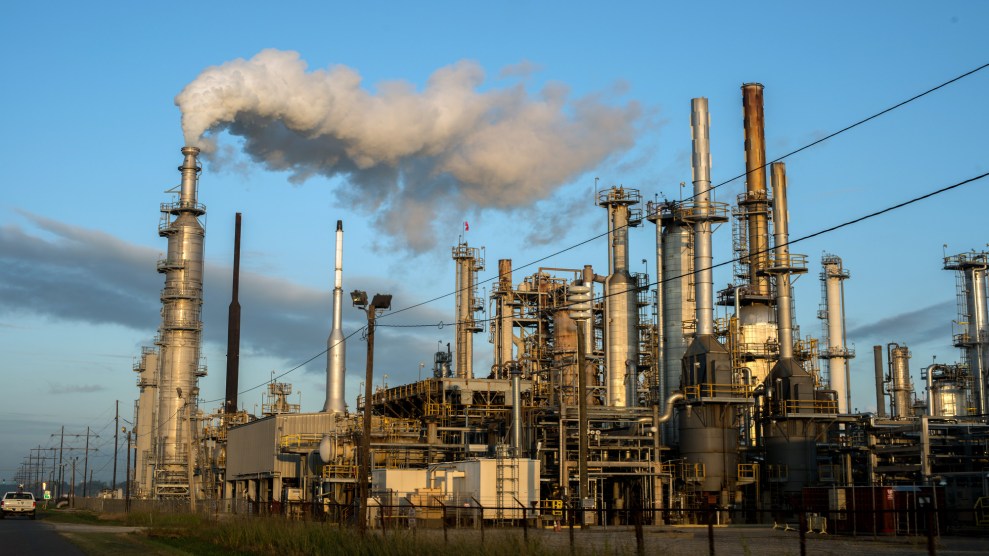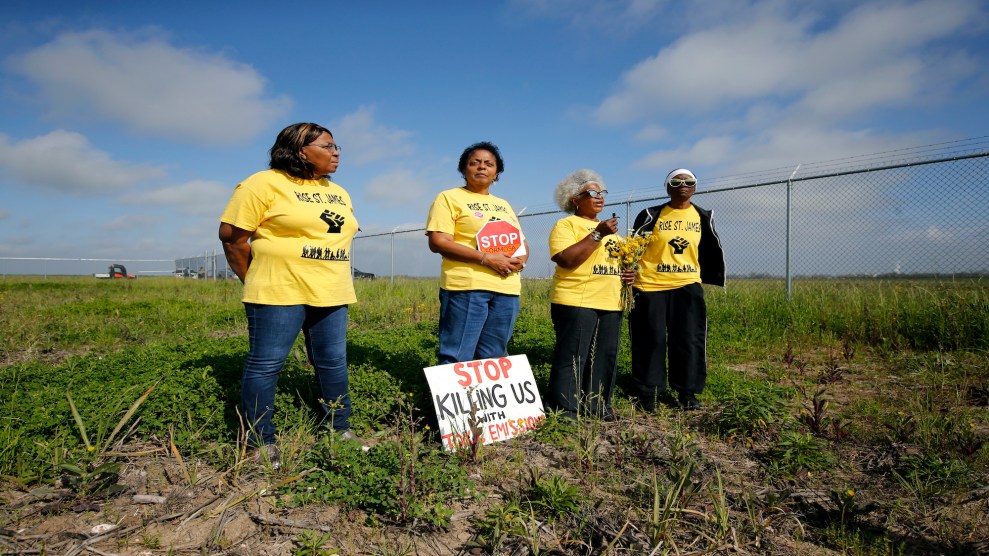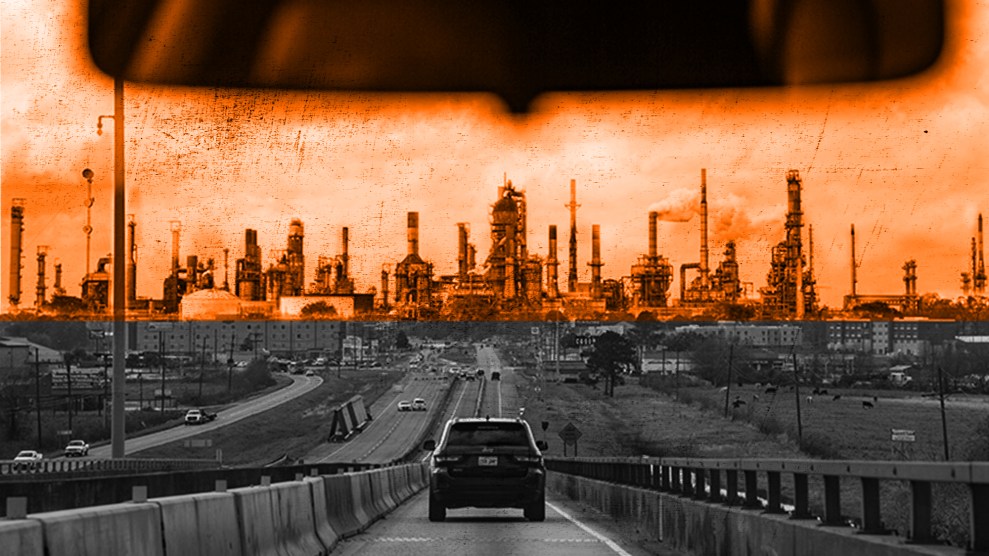
Smoke billows from a Louisiana chemical plant near what activists have dubbed Cancer Alley. Giles Clarke/Getty
This story was originally published by the Guardian and is reproduced here as part of the Climate Desk collaboration.
The US Justice Department has sued the two petrochemical giants behind a facility in Louisiana’s “Cancer Alley” responsible for the nation’s highest cancer-risk rates caused by air pollution—a major lawsuit that seeks to substantially curb the plant’s emissions.
Unveiled on Tuesday, the lawsuit alleges emissions at the Pontchartrain Works facility in Reserve, Louisiana, violate the Clean Air Act and “present an imminent and substantial endangerment to public health and welfare.”
The move marks a significant escalation of the Biden administration’s enforcement action in the Cancer Alley region, and was instantly hailed by members of the predominantly Black community around the plant as a major victory in their ongoing campaign for clean air.
Suing on behalf of the Environmental Protection Agency, the Justice Department is now seeking a federal court order to compel Denka, the Japanese chemical giant operating the facility, to “immediately take all necessary measures” to curb emissions of the compound chloroprene, labeled by the EPA as a likely human carcinogen.
The facility is the only site in the US to emit the compound, which is a primary constituent of the synthetic rubber neoprene. EPA air monitoring around the facility has consistently shown readings well in excess of the recommended lifetime exposure limit of 0.2 micrograms per cubic meter. “This will have a tremendous impact on our struggle here,” said Robert Taylor, a founder of Concerned Citizens of St John Parish. “Over the six years we have been fighting this fight we haven’t had anything as great as this to happen in terms of getting concrete action on emissions.”
Speaking to the Guardian, Taylor added: “The state government has totally ignored us—marches on the capitol, rallying—they wouldn’t even give us an audience. And for the administration to come in and do this, it just validates our efforts.”
EPA administrator Michael Regan said in a statement that he had promised “strong action” for community members during a site visit to Reserve in November 2021. “This complaint filed against Denka delivers on that promise,” Regan said. “The company has not moved far enough or fast enough to reduce emissions or ensure the safety of the surrounding community. This action is not the first step we have taken to reduce risks to the people living in St John the Baptist Parish, and it will not be the last.”
A statement issued by Denka on Tuesday said the company “strongly disagrees” with the legal action and urged the EPA to re-evaluate its findings on chloroprene exposure. The company has been lobbying the federal government for years, claiming the compound’s peer-reviewed classification is based on outdated science.
“DPE is in compliance with its air permits and applicable law. EPA is taking an unprecedented step—deviating from its permitting and rulemaking authorities—to allege an ‘emergency’ based on outdated and erroneous science the agency released over 12 years ago,” the statement said.
The lawsuit also names a subsidiary of the US chemicals giant DuPont, which constructed the Pontchartrain Works facility as a neoprene plant and operated it for over half a century. DuPont sold the plant to Denka in 2015 in a secretive deal, which the Guardian later revealed was motivated by concerns from DuPont that it would face heavier regulation after the EPA’s decision to classify chloroprene as a likely human carcinogen. The revelations were part of a years-long Guardian series examining air pollution in Reserve and throughout Cancer Alley.
DuPont remains the owner of the land beneath Denka’s facility and acts as a landlord, according to the complaint, meaning DuPont may need to grant permissions in order for emissions to be reduced. (DuPont did not immediately respond to a request for comment.)
In a statement, Associate Attorney General Vanita Gupta said: “The justice department’s environmental justice efforts require ensuring that every community, no matter its demographics, can breathe clean air and drink clean water. Our suit aims to stop Denka’s dangerous pollution.”
The lawsuit contains further details of the plant’s recent chloroprene emissions, which fell after Denka constructed emissions offset technology after its purchase of the plant, but still remains dangerously high and in some locations 14 times over the recommended exposure limit.
According to EPA calculations in the suit, current chloroprene emissions present a risk “that is especially grave for infants and children under the age of 16.” The suit claims that emissions remain so high that a child breathing air near certain monitors around the facility’s fence line would exceed their lifetime excess cancer risk within two years.
“In the aggregate, the thousands of people breathing this air are incurring a significantly higher cancer risk than would be typically allowed, and they are being exposed to a much greater cancer risk from Denka’s air pollution than the majority of United States residents face,” the suit states.
The justice department complaint does not directly specify that Denka should reduce its emissions to the 0.2 micrograms lifetime exposure recommendation, but cites the guidance throughout the complaint.
Mary Hampton, another founder of Concerned Citizens of St John Parish, said the lawsuit was the culmination of years of advocacy from community members and represented that “finally we have a little hope…This makes me feel like we have something to look forward to, not five or 10 years from now—we need it to happen now.”
Hampton urged both Denka and DuPont to comply with the federal government’s demands set forth in the lawsuit. “They know they can comply,” Hampton said. “And either they use their money and do it right or face the power of the EPA.”












